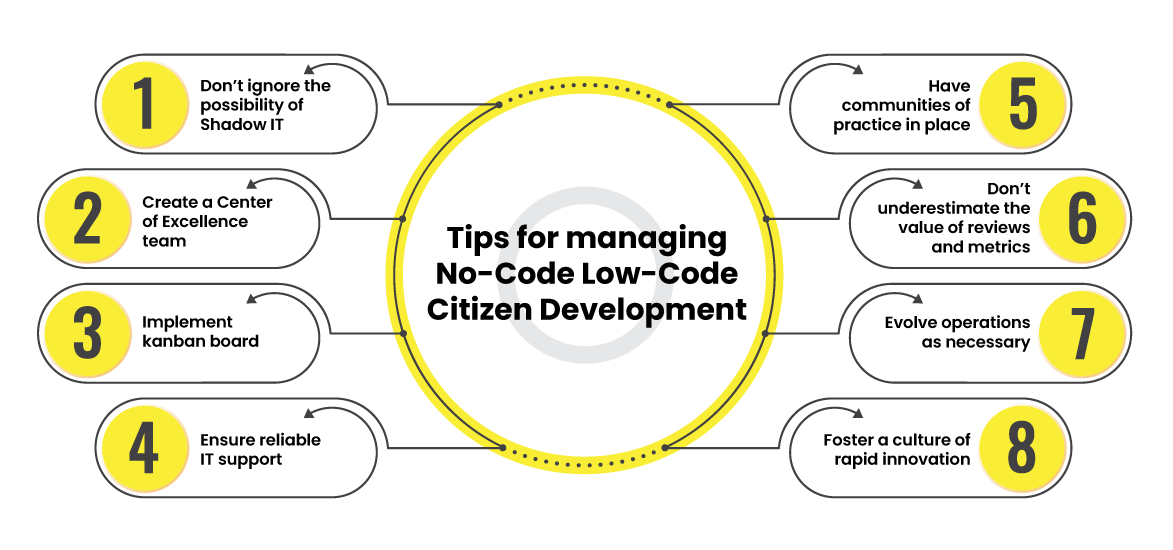
This article was first published on Customer Think
The philosophy of no-code low-code technology — that business users can build their solutions all on their own — resonates with enterprises. According to Gartner, by 2026, developers outside formal IT departments will account for at least 80% of the user base for low-code development tools, up from 60% in 2021.
But with these benefits comes greater risks – like the one that comes with the autonomy of creating anything they like. Therefore, governance has become a key IT consideration.
While rigorous governance structures are yet to be implemented widely, IT leaders are beginning to address the issue of managing no-code. They understand that they want to empower a large number of people to do technology work, and they want to do it in a quasi-manner.
No-code platforms boost productivity, reduce costs, and often result in a cultural shift that strengthens relationships between the business and IT. With a culture of digital problem-solving, no-code can help organizations achieve the kind of ongoing improvement that business transformation has always assured.
Tips for managing No-Code Low-Code Citizen Developers
Here are the 8 important tips for IT leaders that can help them pragmatically manage no-code low-code citizen development, i.e., mitigate risks without discouraging experimentation and self-service.

1. Don’t ignore the possibility of Shadow IT
When arguing against no-code platforms, CEOs and CIOs frequently bring up “shadow IT.” They argue that no-code platforms enable citizen developers, or at the very least allow them to build applications independently without the intervention of IT – and that there is a risk associated with it. What is the danger?
Citizen developers may end up creating half-baked applications that the IT team is unaware of. Such inept applications may float across departments, thwarting the organization’s innovation goals. To put it another way, no-code platforms have the potential to enable business users to form a “secret society of application development.” This secret society is known as Shadow IT.
The harm of Shadow IT
- Shadow IT can derail your entire innovation program by making no-code development unaccountable in your organization.
- Shadow IT gives the illusion that no-code platforms demand no basic training, and anybody can step in and start building applications, which is not the case.
- Shadow IT results in unsupervised data-sharing and reporting within an organization, jeopardizing internal information and key assets.
- Shadow IT creates systems that may not be interoperable with other internal programs.
A well-established IT governance model can provide much-needed accountability while also transforming no-code development into a collaborative process. Your IT governance model can be top-down, with a single authority governing your entire citizen development program, where each program may contain multiple projects and initiatives. This office can be located within your IT department and led by your CTO.
2. Create a Center of Excellence team
Adopting, promoting, and scaling no-code is an enterprise-wide responsibility that necessitates forming an internal team or CoE comprised of individuals with diverse areas of expertise. This team is responsible for overseeing citizen development activities across organizations, defining best practices, and providing ongoing support to all no-code implementations.
Key functions of CoE
- To choose the best possible no-code platform.
- To clearly articulate the roles and responsibilities of team members supporting no-code initiatives.
- To identify and prioritize no-code projects.
- To establish IT requirements, access control, security & compliance, and identity management guidelines.
- To identify and address areas of improvement throughout the software development lifecycle.
- To assess the impact of no-code solutions, in terms of user experience and process efficiency.
- To assess the resource gaps in the existing CoE team.
IT leaders can try out these models for CoE.
a. Centralized CoE
As the name implies, a core team (single point of contact) handles CoE functions and distributes tasks and functions throughout the organization in this model. Scaling no-code development is simpler in a centralized model, but the core team’s reliability is critical; otherwise, the entire project may become rigged with capacity constraints.
b. Federated CoE
The CoE is divided into business units in this model, with each unit having its own range of abilities, guidelines, team structures, and business-critical priorities. Teams can use no-code platforms to create unique applications for their processes. Different versions of truth and expectations about no-code development may exist because there is no single reference point or a common reference point. As a result, scaling and moving in one direction may be difficult for an organization.
c. Hybrid CoE
As both centralized and federated CoEs have advantages and disadvantages, organizations can choose a blended or hybrid model in which a core team supports operations and delivery while business units maintain their mission-critical priorities, team structure, and governance.
3. Implement kanban board
The majority of IT operations are not physical in nature and cannot be visualized in the same way that line assembly items can. Cross-functional teams can use a kanban board – an agile project management tool – to identify bottlenecks and improve workflow.
With the help of visual cards and columns, it provides team members with a wider view of suggested ideas, tasks that have yet to begin, and work-in-progress items. Each column represents a different workflow, and each workflow has a different number of visual cards or tasks. This approach can increase oversight and integrity within teams while also ensuring an iterative application development process free of roadblocks, arbitrary deadlines, and last-minute changes. If some resources are underused, appropriate work can be assigned to them.

4. Ensure reliable IT support
Just having a robust governance architecture in place isn’t enough, and CIOs should ensure foolproof IT support and resources for citizen developers. Building a sense of collaboration between IT and citizen developers is essential in this regard.
IT leaders can formalize citizen development by including different zones such as:
Green zone – where citizen developers can create workflows and automation
Yellow zone – where citizen developers work with professional developers to build more robust applications and have a major say in the overall development process
Red zone – where citizen developers require IT oversight and approval to build complex and business-critical applications
They can create a centre of excellence team (as mentioned in the second pointer) to build APIs or enable fusion teams with pro developers who work in both no-code and traditional development environments. This kind of collaboration and support is what differentiates no-code from Shadow IT.
Citizen development is all about creating an environment where business users can use no-code tools without the fear of being reprimanded. It ensures a learning path for non-technical individuals who want to actively build applications and aren’t satisfied playing the side role. Such a collaborative environment can give them the comfort of asking for help from power users and the IT community at large.
5. Have communities of practice in place
A community of practice is a group of people (both technical and non-technical) who “share a common concern or a passion for things they do and learn how to do it better as they interact regularly.”
Collaboration and cross-functional coherence are the foundations of effective citizen development practices. In an organization, communities of practice promote both of these aspects. It encourages knowledge sharing among technical and non-technical teams, assisting them in establishing best practices and understanding each other’s future innovation plans. For example, business teams can discuss how they intend to use no-code platforms to build bespoke applications while reducing their reliance on technical personnel. This enables IT leaders, to allocate resources wisely and reduce the existing backlog.
Communities of practice can exist within organizations for a variety of topics such as operations, development, information security, regulatory compliance, and so on. To achieve the best results, the leadership team should discuss the group’s objectives and hold regular briefings and brainstorming sessions with all parties involved.
Also read: The Pros and Cons of Citizen Development
6. Don’t underestimate the value of reviews and metrics
Individual business users who are busy building their customized solutions are unlikely to pay enough heed to business metrics or any type of feedback mechanism. Introducing metrics such as “time is taken to complete a process” and ensuring regular reviews to track performance and analyze opportunities for further development can be beneficial. It can help IT teams identify and cease inefficient processes, as automating a bad process can accelerate bad outcomes.
No-code low-code platforms can be leveraged to build process mining tools to determine inefficiencies or additional work that some citizen developers may be performing and help them prioritize their responsibilities. It will help them build apps that align with the larger strategic objective of the enterprise rather than building apps that provide makeshift solutions.
7. Evolve operations as necessary
Analytics and monitoring tools in no-code platforms can not only track API usage but also notify you of apps that have grown so popular or business-critical. It is the responsibility of IT to ensure the sustainability of business innovation – groundbreaking ideas that turn into apps that are so popular that they require more IT support.
In practice, this progression can cause friction; the original low-code developer may be concerned about IT assuming control of the tool, and the IT team may be concerned about supporting an app that they did not create or specify. A collaborative culture between business and IT should help all parties avoid suspicions.
8. Foster a culture of rapid innovation
During COVID-19, alternative business models gathered momentum and are now gaining velocity in post-pandemic times. Digital transformation and digital acceleration have become the must-haves for future innovation/business strategies/initiatives. Global spending on these efforts is expected to reach $2.3 trillion by 2023.
The idea is to find the sweet spot between existing capabilities and future expectations. Enterprises can harness cloud, AI, and intelligent automation to meet and exceed ever-rising customer expectations while staying ahead of the curve. There is a prominent need for organizations to evolve the way their business and technical teams operate and innovate, and they can do so by becoming operationally agile across their setup. IT leaders need to turn their workforce into a network of high-performing, interconnected teams that can be creative with technology and build bespoke applications for their mission-critical priorities – all on their own. Organizations need to develop operational and strategic agility for:
- Handling business turbulence triggered by market dynamics, competitive pressures, and natural calamities like COVID-19
- Overcoming IT skill shortages
- Democratizing software development
- Encouraging business users (citizen developers) to be creative with technology and build bespoke applications using no-code platforms
- Effectively managing incremental changes
- Achieving rapid innovation cycles
- Assessing risk and strategies to mitigate adverse outcomes
Also read eBook: Driving Rapid Enterprise Innovation with Citizen Developers
Takeaway
As more and more organizations adopt a hybrid workforce model (with on-premise IT teams), it’s essential to push non-technical employees towards citizen development and not overwhelm remote-based IT teams with everyday troubleshooting. No-code platforms like Quixy are democratizing and pacing up innovation – letting business analysts, product designers, and marketers build their respective applications without writing a single line of code. They are truly leading the efforts to nurture code-agnostic development teams.
Login
Please login to comment
0 Comments
Oldest















